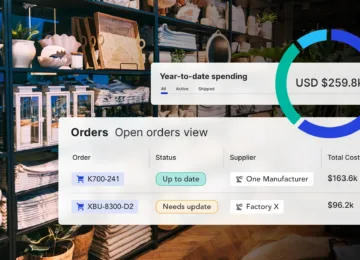The retail landscape is no stranger to disruptions, and supply chain delays have emerged as one of the most critical risks that can send shockwaves through brands. With the potential to diminish customer satisfaction, trigger reputational damage, and cause financial losses, retailers must understand the dangers of supply chain delay risk to fortify their supply chains.
The key to this is delving into the metrics that matter most. In this blog, we unravel the complexities of supply chain delay risk and present you with five essential metrics that demand your attention. By understanding and tracking these key indicators, you’ll not only gain a clearer picture of your supply chain’s resilience but also empower your brand to proactively navigate the ever-changing currents of supply chain management.
First, let’s break down how your team should treat delay risks and explore the role delay risk metrics play in preparing your business for disruptions.
How to Think About Delay Risks
Delays are among the biggest threats to supply chain efficiency. Nearly 60% of businesses surveyed by Anvyl report that supply chain delays have caused them to lose up to 15% or greater in revenue.
Of course, there are risk factors you can’t control, like natural disasters. But there are numerous delay risks you can prepare for – and even avoid. For example, you choose the geographical locations of your supplier base. Therefore, you have the power to choose suppliers that can facilitate shorter lead times, or are based in countries with trouble-free customs and trade regulations.
Similarly, you also have control over how you communicate and collaborate across your supply chain. This means you have the power to mitigate order discrepancies and misunderstandings caused by inadequate communication, and which lead to damaging delays.
Now, let’s delve into the world of delay risk metrics and the 5 most important indicators to track.
What is a Delay Risk Metric?
A delay risk metric is a quantifiable measure or indicator that you can use to assess and manage potential delay risks within your supply chain. These metrics help you identify, measure, and understand factors that could lead to delays in the production, distribution, or delivery of your goods. By monitoring these metrics, you can proactively manage and mitigate risks, enhance supply chain resilience, and maintain operational efficiency.
5 Must-Track Supply Chain Delay Risk Metrics
- Days Estimated Lead Time
Lead time is the amount of time that passes from the start of a process until its conclusion. So, when managing your inventory, this would be the amount of time between when a purchase order is placed to replenish products and when the order is received in your warehouse.
Typically, lead times can vary – and the more suppliers involved in the chain, the longer the lead time is likely to be. Or, when demand increases, as it has globally, suppliers have more client orders to fulfill – which will increase the lead time required on all orders.
Logistics issues and extended lead times present a constant threat for supply chain managers, so it’s important to build a significant cushion to ensure your goods get delivered on time.
- Days Before Estimated Ship Date
This next one may seem simple and straightforward – but you’d be surprised how often it is the source of supply chain delays.
If your supplier requires 60 days lead time, and you place an order that needs to be shipped in 30 days – you can expect delays. Unless you have a strong relationship with your supplier and they will prioritize your order, you will not receive your goods on time. It’s important to understand the degree of flexibility with any given supplier.
- On-Time Delivery Performance
On-time delivery performance is one of the most important KPIs to track across your supply chain. It involves tracking the percentage of orders or shipments that are delivered according to your agreed-upon schedule with your supplier. This metric offers valuable insights into the performance of suppliers, carriers, and logistics partners, playing a pivotal role in maintaining customer satisfaction and overall supply chain effectiveness.
Late deliveries, on the other hand, can lead to stockouts, increased operational costs, lost sales opportunities, and strained supplier relationships. It’s therefore imperative that you use your purchase order management platform to regularly monitor on-time delivery performance, and continuously track the movement of goods through your supply chain.
- Customs Clearance Time
Global supply chains often involve the movement of goods across international borders, and customs clearance can significantly impact delivery timelines. This process involves the inspection and approval of shipments by customs authorities, ensuring compliance with regulations and facilitating the smooth flow of goods.
Delays in customs clearance can be caused by documentation issues, regulatory changes, or high volumes of shipments. Understanding and mitigating these delays are crucial for maintaining efficient delivery timelines.
It’s crucial to stay informed about the customs clearance process in the countries involved in your supply chain and work closely with customs brokers to expedite the process whenever possible. In addition to regularly tracking the status of all shipments, you should conduct risk assessments to identify potential issues that could lead to customs clearance delays. Develop contingency plans for addressing these delays, including alternative transportation routes, expedited clearance options, or buffer times in production schedules.
- Inventory Replenishment Time
Inventory replenishment time refers to the duration it takes to restock and replenish inventory levels once they reach a predetermined threshold, often known as the reorder point. Efficient management of inventory replenishment time is crucial for maintaining optimal stock levels and meeting customer demand.
You must monitor inventory levels in real-time and set clear reorder points based on demand forecasts and historical sales data. Regularly review and update these points to adapt to changes in demand patterns or market conditions. You can also utilize supply chain management systems, like Anvyl’s intelligent purchase order management tool, to automate replenishment processes.
Also important is collaborating closely with suppliers to optimize order processing and reduce lead times for replenishment. Again, a modern supply chain management solution like Anvyl’s facilitates seamless communication and coordination, making it easier to build mutually beneficial supplier relationships.
Mitigate Supply Chain Delays With Anvyl
The key to mitigating supply chain delays is having real-time visibility into your supply chain. The ability to instantly access and analyze data at every stage of the supply chain empowers organizations to proactively identify potential disruptions. These real-time insights enable swift decision-making, allowing your business to implement timely interventions, reroute resources, and collaborate effectively with stakeholders to prevent delays from rippling through the supply chain.
Anvyl’s intelligent purchase order management platform provides a comprehensive and up-to-the-minute view of operations. Our solution forms the foundation for data-driven strategies, continuous improvement, and the overall resilience of the supply chain against unforeseen challenges.
With our technology, you:
- Always know the status of purchase orders. Reduce the risk of delays with real-time visibility into your entire PO process, allowing you to track and monitor each stage of the procurement process effortlessly.
- Boost supply chain efficiency with automation. Keep your ship running smoothly with auto-check-ins, auto-escalations and auto-reminders designed to communicate everything your team needs to know.
- Boost supplier relationships. Our platform facilitates seamless communication and collaboration between you and your suppliers. Our supplier scorecards also give you a clear view of supplier performance over time.
- Identify delays before they happen. Anticipate supply chain delays based on historical and current information. Our technology lets you see around corners for at-risk orders, eliminating the need to scramble and preventing costly adjustments.
Anvyl is proud to work with top DTC brands to help them reduce supply chain delay risks. To learn more about how we can help you avoid supply chain disruptions and optimize procurement management, contact us today!



